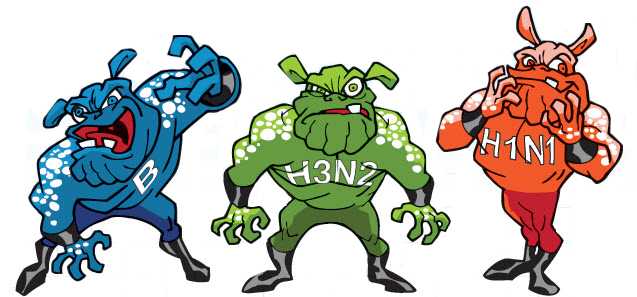Case file: The Flu Krew
- Real name: influenza
- Microbe type: virus
PROFILE
Influenza viruses, AKA the “Flu Krew,” are viruses spread mainly by coughs and sneezes. If you get sick with these viruses, you may have a fever, cough, sore throat, runny or stuffy nose, body aches, headaches, chills, or tiredness. The Flu Krew roams the globe, appearing in the United States during flu season, which can happen between October and May. The members of the Flu Krew, called viruses, usually change a little bit each year. Scientists and flu experts keep a close watch on the Flu Krew and work with doctors and others to help protect us from flu. The best way to prevent flu is with a flu vaccine, but there also are medicines to treat flu.

Powers & Abilities
The Flu Krew’s three sinister tricks make it tough to combat.
- Flu Krew can change each year, and outwit past vaccines.
- Flu is contagious and can spread easily from person to person.
- Infected people are contagious for about a day before they even know they’re sick.
Symptoms of the flu can include some or all of the following:
- Fever (but some people can have flu without a fever)
- Cough
- Sore throat
- Runny or stuffy nose
- Body aches
- Headache

- Chills
- Tiredness
- Diarrhea
- Vomiting
This sounds like a plain old cold, right? Wrong. The Flu Krew’s assault is sudden, and can be far more powerful than a cold.
The best way to fight the Flu Krew is to get vaccinated, but you can reduce the chances that the Flu Krew will get to you by staying away from people who are sick. By covering your coughs and sneezes, and washing your hands, you can reduce the chances of spreading the virus to other people. The greatest reasons to be concerned about the Flu Krew are::
•The Flu Krew can cause mild as well as serious illness. Most of the time, people that get sick with flu will recover in less than 2 weeks. However, sometimes the Flu Krew lands even healthy kids and adults in the hospital. Some people are more likely to get very sick from the flu, like young children, pregnant women, older people, and people with certain medical conditions like diabetes, asthma, kidney disease, or heart disease. For a complete list of people who are at high risk of serious flu complications, see http://www.cdc.gov/flu/about/disease/high_risk.htm.
•The Flu Krew is unpredictable and can affect people differently. Even healthy people can get very sick from the flu and spread it to others. Each year, more than 200,000 people in the United States end up hospitalized because of the Flu Krew, and between 3,000 and 49,000 people die.

KNOWN WEAKNESSES
Each season’s flu vaccine is the best protection against this Flu Krew. The vaccine trains your own immune system to recognize and fight the Flu Krew if they enter your body.
Members of the Flu Krew change a little each year. Scientists keep a close watch on the Flu Krew and try to anticipate what virus members will be most common on the Krew the next flu season, in order to make a vaccine that works against the Krew.
For the best protection, people must get a flu vaccine each year. Some kids, younger than 9 years old will need to get two doses of flu vaccine to be protected. Do you have a brother or sister who might need two doses? Make sure to remind your parents to ask the doctor. They’ll be impressed by your Flu Krew knowledge!
Keeping this enemy in check requires real vigilance. If you think the Flu Krew is making you sick, tell your parent(s) or guardian. Everyone must do what they can to prevent the Flu Krew from spreading their attack. This means staying home when you’re sick, cover¬ing up coughs and sneezes with a tissue, and washing hands often.
If you have the flu, your doctor may give you anti-flu medicines called “antivirals” that are a second line defense to treat your flu illness. Antivirals can help you get better faster. Not everyone needs antivirals, but people who have certain medical conditions, like asthma should get them.
PREFFERED VICTIMS
The Flu Krew can infect anybody, anywhere.
PRECAUTIONS FOR THE PUBLIC
Our main weapon against the Flu Krew is flu vaccine. Flu vaccine comes in two forms—a shot and a nasal (nose) spray, and neither one can give you the flu.
Flu season in the United States can start as early as October and last as late as May. It’s best to get vaccinated soon after the vaccine is available. But, the saying “better late than never” is true—even later in the season, the vaccine can help protect you against the Flu Krew.
Remember, you can protect yourself and others by:
- Steering clear of people who are sick.
- Staying home from school, and away from others as much as possible, if you’ve been attacked by the Flu Krew.
- Covering up coughs and sneezes us¬ing a tissue, or your elbow if tissue is not available, instead of your hand.
- Not touching your mouth, nose, or eyes (which is how germs spread).
- Washing hands often with soap and water, especially after you cough or sneeze.
 CRIMINAL RECORD
CRIMINAL RECORD
The Flu Krew has an established track record of several frightening outbreaks and other tricky behavior.
- A flu pandemic is a worldwide outbreak of disease that occurs when a new flu virus— AKA, a new Flu Krew member—emerges and causes illness in people around the world.
- In 2009, a new Flu Krew member emerged called “2009 H1N1.” Since 2009, this new virus member has been included in the yearly Flu Krew vaccine. This virus spreads easily from one person to another, just like other Flu Krew members, but tends to hit young and middle-aged adults harder than other Flu Krew members, causing them to be hospitalized more and sometimes even die.
- The worst Flu Krew pandemic ever was the 1918 flu pandemic, which killed tens of millions of people.
- Other Flu Krew members caused pandemics during in 1957–58 and 1968–69; these Flu Krew members were not as deadly as the 1918 Flu Krew.
Immune Platoon Disease Database
- Page last reviewed: December 18, 2015
- Page last updated: December 18, 2015
- Content source:



 ShareCompartir
ShareCompartir